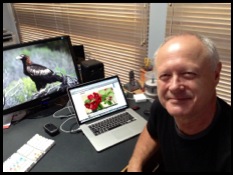Feb 2014
Expedition video gear
17/02/14 15:16
The biggest problems with expedition videography are power, temperature and dust. When I first came to the Himalayas in 1974 on a film shoot with Ed Hillary we had an Éclair film camera and a tea chest of batteries. We used hot water bottles to keep the camera and batteries warm.
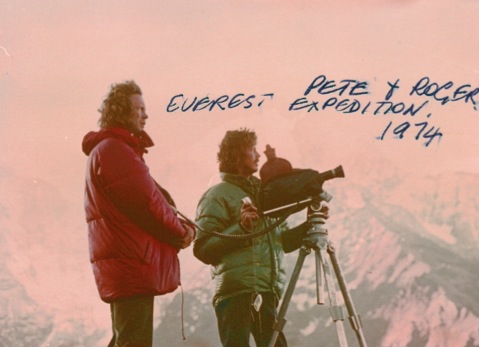
Pete and Roger Donaldson filming with Éclair camera and hot water bottle 1974
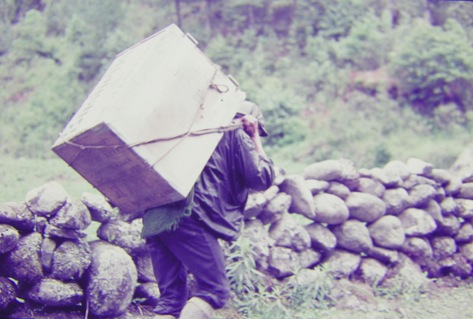
A crate of 12 V lantern batteries in 1974
Modern video equipment uses much less power however digital storage is a problem for a long expedition so two laptop computers must be taken (one as spare). We took a Sony Vaio laptop which could read the special SXS cards directly from the Sony EX1 camera. (Since then cheap card holders using SD cards such as those from MXM https://mxmexpress.com have solved the cost issue) There were two potential problems caused by that approach. Firstly the Vaio consumed around 100 watts and secondly its hard drive like most modern hard drives had a small head gap and was not guaranteed to work over ten thousand feet. Since we were going to twice that I talked to Everest veterans and they suggested an older hard disk. So I installed an old 80 Gb drive into an old LG laptop as an emergency spare. Fortunately I was able to cover shooting above 16000 feet with the cards I had and then download in the valleys. Download disks were ruggedised LaCie units. For power we had a porter carry two 60 watt glass solar cells and an inverter which we set up whenever we stopped. These were used to charge two large Polarmate 200 watt hour lithium ion cells and Sony batteries from which we ran the video camera and computer. The Polarmate cells could provide voltage from 3V to 26V and came with a wide range of connectors. I also carried a small flexible 12 V/6 watt solar cell on my pack to charge small AA cells and still camera batteries. All equipment worked faultlessly apart from a few minor wiring glitches at the start.
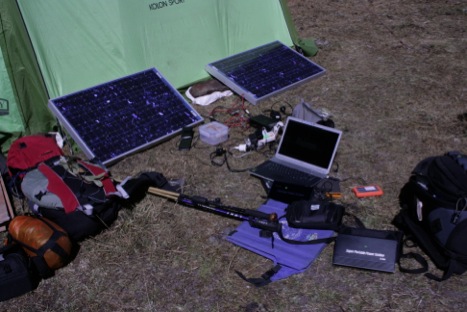
Solar cells plus inverter, laptop and Polarmate lithium ion cell.
Low temperature causes two problems namely poor battery life and condensation. We kept batteries in our down jackets or sleeping bags when not in use. A sealable plastic sack kept moisture and dust from the camera gear. I also carried two catalytic pocket warmers which run on lighter fuel although this creates problems when flying.

Pete and Roger Donaldson filming with Éclair camera and hot water bottle 1974

A crate of 12 V lantern batteries in 1974
Modern video equipment uses much less power however digital storage is a problem for a long expedition so two laptop computers must be taken (one as spare). We took a Sony Vaio laptop which could read the special SXS cards directly from the Sony EX1 camera. (Since then cheap card holders using SD cards such as those from MXM https://mxmexpress.com have solved the cost issue) There were two potential problems caused by that approach. Firstly the Vaio consumed around 100 watts and secondly its hard drive like most modern hard drives had a small head gap and was not guaranteed to work over ten thousand feet. Since we were going to twice that I talked to Everest veterans and they suggested an older hard disk. So I installed an old 80 Gb drive into an old LG laptop as an emergency spare. Fortunately I was able to cover shooting above 16000 feet with the cards I had and then download in the valleys. Download disks were ruggedised LaCie units. For power we had a porter carry two 60 watt glass solar cells and an inverter which we set up whenever we stopped. These were used to charge two large Polarmate 200 watt hour lithium ion cells and Sony batteries from which we ran the video camera and computer. The Polarmate cells could provide voltage from 3V to 26V and came with a wide range of connectors. I also carried a small flexible 12 V/6 watt solar cell on my pack to charge small AA cells and still camera batteries. All equipment worked faultlessly apart from a few minor wiring glitches at the start.

Solar cells plus inverter, laptop and Polarmate lithium ion cell.
Low temperature causes two problems namely poor battery life and condensation. We kept batteries in our down jackets or sleeping bags when not in use. A sealable plastic sack kept moisture and dust from the camera gear. I also carried two catalytic pocket warmers which run on lighter fuel although this creates problems when flying.
The expedition begins...
09/02/14 11:52
The idea for the Joseph Hooker documentary project began in a roundabout way. Forty years ago I was fortunate enough to be a member of a film crew with Sir Edmund Hillary in the Everest region. At that time there were few tourists and we stayed in local homes. Being interested in mountains, I have always wanted to return to film in the Himalayas but have been put off by the number of tourists. So in looking for an area still rarely visited, I thought of the Kangchenjunga region. It is remote and takes weeks of walking to visit so only small numbers of experienced hikers go there. My idea was to make a documentary about a group of fit walkers in their late 60s making this trek.
In researching the idea I soon came across Sir Joseph Hooker’s name as he was the first European to visit the area in 1848. As an ex-scientist with an interest in the formulation of the Theory of Evolution I recognised his name and started looking at his expedition in more detail. Before long I discarded the original idea and decided to make a documentary retracing Hooker’s journey. My plan was to take the identical route at the same time of year and see what had changed. I contacted the Royal Botanic Gardens at Kew and arranged to visit and photograph many of their Hooker artefacts as I wanted to compare Hooker’s drawings with what one sees now. Kew was extremely responsive to this request by an unknown film maker who at that stage had only fairly well formed plans, and I cannot thank them enough. I interviewed Hooker expert Jim Endersby and others and filmed at many places in London as well as at Darwin’s home and elsewhere.
The next step was to arrange the Himalayan expedition. Through contacts I was put in touch with Jamie McGuinness of Project Himalaya www.project-himalaya.com/about-jamie-mcguinness.html in Kathmandu. Jamie has climbed Everest several times and was very helpful. He assigned his top sirdar Dagelje Sherpa to arrange and lead the support team. Dagelje, or Dawa as he is known, www.facebook.com/dagelje.sherpa has also climbed Everest several times and is a very famous sherpa who has been over 8000m more than 40 times. He is a founder of the High Altitude Mountain Workers Welfare Association a very important group for a high risk occupation. Just ambling down a street in Kathmandu with Dawa is quite an experience as he is so well known. During the expedition Dawa and I walked together most days discussing everything from Buddhism (he was initially a young monk) to his family and exploits. We became close friends and remain in contact. Dawa arranged for five sherpas to travel from Kathmandu by road for nearly a week with most of our equipment and for eighteen local porters to be hired to meet us at the short landing and takeoff strip at Suketar .
I persuaded three young Australians to become the film crew. My nephew Aaron Donaldson who is a doctor, mountain bike racer and interested in video signed up. Dan Novak, a young outdoors man working on the Fox Eradication program in Tasmania and a very good photographer agreed to come. Dan and I had previously walked the beautiful Tasmanian Overland Track together. Aaron and Dan were to share the filming. The third person was Jason Taffel. Jason is the nephew of a walking mate of mine and works in a climbing store and is very interested in the outdoors. His job was to record sound and help with reflector lighting. It turned out to be a great fun crew who all got along very well.
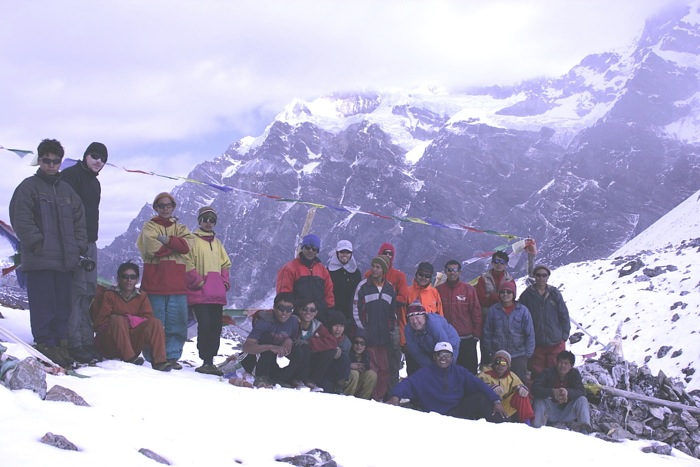
Most of the team at Nango Pass.
Next week: some technical nitty gritty.
In researching the idea I soon came across Sir Joseph Hooker’s name as he was the first European to visit the area in 1848. As an ex-scientist with an interest in the formulation of the Theory of Evolution I recognised his name and started looking at his expedition in more detail. Before long I discarded the original idea and decided to make a documentary retracing Hooker’s journey. My plan was to take the identical route at the same time of year and see what had changed. I contacted the Royal Botanic Gardens at Kew and arranged to visit and photograph many of their Hooker artefacts as I wanted to compare Hooker’s drawings with what one sees now. Kew was extremely responsive to this request by an unknown film maker who at that stage had only fairly well formed plans, and I cannot thank them enough. I interviewed Hooker expert Jim Endersby and others and filmed at many places in London as well as at Darwin’s home and elsewhere.
The next step was to arrange the Himalayan expedition. Through contacts I was put in touch with Jamie McGuinness of Project Himalaya www.project-himalaya.com/about-jamie-mcguinness.html in Kathmandu. Jamie has climbed Everest several times and was very helpful. He assigned his top sirdar Dagelje Sherpa to arrange and lead the support team. Dagelje, or Dawa as he is known, www.facebook.com/dagelje.sherpa has also climbed Everest several times and is a very famous sherpa who has been over 8000m more than 40 times. He is a founder of the High Altitude Mountain Workers Welfare Association a very important group for a high risk occupation. Just ambling down a street in Kathmandu with Dawa is quite an experience as he is so well known. During the expedition Dawa and I walked together most days discussing everything from Buddhism (he was initially a young monk) to his family and exploits. We became close friends and remain in contact. Dawa arranged for five sherpas to travel from Kathmandu by road for nearly a week with most of our equipment and for eighteen local porters to be hired to meet us at the short landing and takeoff strip at Suketar .
I persuaded three young Australians to become the film crew. My nephew Aaron Donaldson who is a doctor, mountain bike racer and interested in video signed up. Dan Novak, a young outdoors man working on the Fox Eradication program in Tasmania and a very good photographer agreed to come. Dan and I had previously walked the beautiful Tasmanian Overland Track together. Aaron and Dan were to share the filming. The third person was Jason Taffel. Jason is the nephew of a walking mate of mine and works in a climbing store and is very interested in the outdoors. His job was to record sound and help with reflector lighting. It turned out to be a great fun crew who all got along very well.

Most of the team at Nango Pass.
Next week: some technical nitty gritty.


